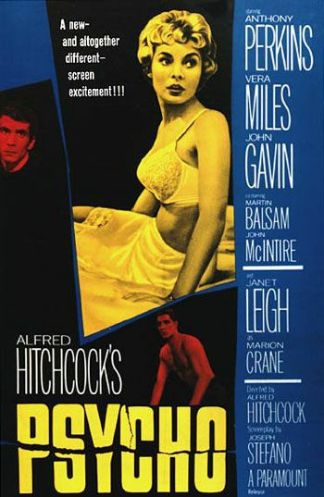
Movies and television, such as Psycho, portray mental illness in various ways. (Courtesy of Flickr)
By Bailey Hosfelt
It comes as no surprise that college students fall into the large number of consumers who watch television and movies on a regular basis. With hundreds of theaters in the city and thousands of titles available on Netflix or Hulu, students have the ability to watch the latest box office hit or last night’s premiere through a multitude of mediums. Even residence halls throw viewing parties for the Oscars and friends gather each week to watch their favorite shows.
Movies and TV shows alike serve as outlets where individuals can escape their day-to-day lives and watch someone else’s. People resonate with fictional characters and story lines that do not match their own. What unfolds on camera never truly matches reality, but what happens when people start to believe that it does?
Studies indicate that mass media is a primary source for the public to gain information about mental illnesses such as depression, bipolar disorder or schizophrenia. Popular movies and TV shows shape viewers’ understandings of these disorders, but research conducted by psychologists has found that many on-screen portrayals of the mentally ill perpetuate stereotypes and educate audiences with inaccuracies.
Stephen Hinshaw, a professor of psychology at the University of California-Berkeley believes the worst stereotypes come out in such depictions. “Mentally ill individuals [are depicted] as incompetent, dangerous, slovenly and undeserving. The portrayals serve to distance ‘them’ from the rest of ‘us,’” he said in an interview with U.S. News & World Report.
One of the most popular myths prolonged by the entertainment industry is that mentally ill individuals are violent. In the 1960 classic film, Psycho, the schizophrenic main character dresses as his mother and stabs guests who stay at the hotel he manages. Movies like this one allow audiences to believe that people who suffer from schizophrenia are dangerous, highly volatile individuals who will murder you while screeching violins increase in volume.
Although this scenario is far from realistic, the American Psychiatric Association found that 61 percent of Americans believe people with schizophrenia have violent tendencies. This number can certainly be linked to the media’s portrayal of mentally ill characters with frightening tendencies that border on the line of lunacy.
Media depictions often perpetuate the stigma that mentally ill people are beyond help. Many movies and television shows portray psychiatric hospitals as white-walled, dark, prison-like facilities rather than places where people can go to heal.
The quality of mental health care is the product of various governmental reforms over past decades. Unfortunately, the public’s opinion of them is the product of outdated on-screen depictions of a patient dragged against his or her will into a psychiatric ward.
While some myths are exaggerated and easier to pinpoint as being false, subtle misconceptions continue on camera. Whether it is the belief that the mentally ill all have physical trait, that are “off” or the romanticized idea that these characters fit the mysterious yet attractive “tortured artist” archetype, such myths only further the damaging ‘them’ versus ‘us’ dichotomy stressed by Hinshaw.
The belief that mentally ill individuals match media stereotypes overlooks the fact that these people usually look and act exactly like their peers. The inner struggles fought by those with mental illnesses are not going to simply reveal unkempt hair or wild eyes. People with mental disorders often mask their symptoms to those around them and go about their days in a seemingly regular fashion.
Despite the large number of on-screen depictions of mental illnesses that are either outdated, untrue or a combination of both, recent releases have been able to convey the topic in a more realistic manner.
Movies like Aviator and Silver Linings Playbook display mental illness in a more truthful light. Leonardo DiCaprio plays Howard Hughes, a man struggling with obsessive compulsive disorder in Aviator, while Bradley Cooper plays a bipolar man in Silver Linings Playbook. The latter film was commended by critics for its ability to bring out viewers’ empathy to recognize that mentally ill individuals must be supported instead of overlooked.
Additionally, many TV show writers on series including “Castle,” “Elementary” and “Homeland” have received recognition from the Voice Awards program, a partner of the American Counseling Association that honors those who have raised awareness about mental health through film and television. This demonstrates that the media industry is making strides in the right direction, a precedent that must be followed off screen and onto college campuses.
The fact that a large majority of college students frequently watch movies and TV shows is not surprising. However, the statistic that one in four young adults between the ages of 18 and 24 suffer from mental illness may come as a shock.
The National Alliance on Mental Illness found that concern of stigma was cited as the number one reason why an overwhelming 57 percent of students with diagnosable mental conditions do not seek assistance from their school.
In an environment where stress runs rampant and students have rigorous schedules filled with many responsibilities, it is imperative that mental heath is recognized and validated instead of being interpreted as a sign of weakness.
Each student who walks through the doors of health services or confides in a friend is a real person, not a fictional character concocted in a writer’s room or a violent criminal at the forefront of a horror movie.
Ultimately, it is time that everyone recognizes the impact media portrayals have on public perceptions. It is time we strip stereotypes and stigmas from conversations about mental illness and separate fact from fiction.
